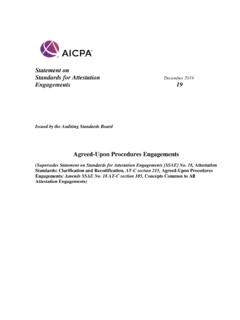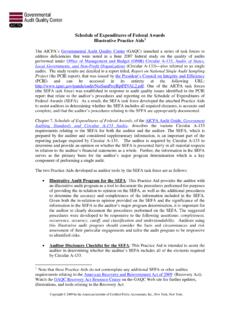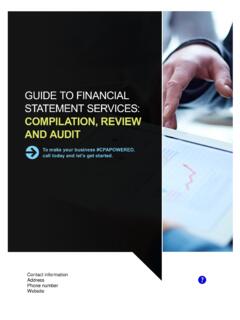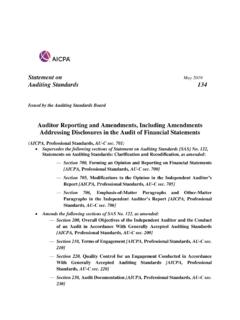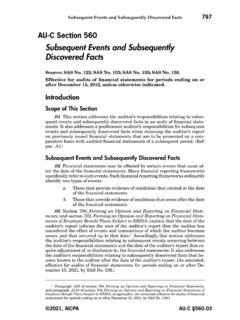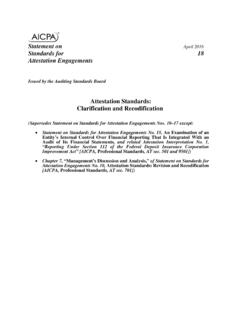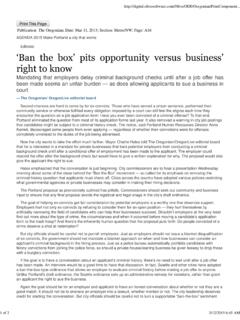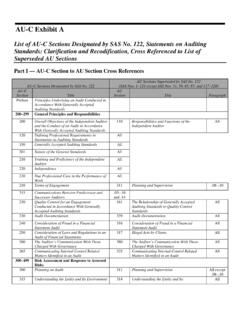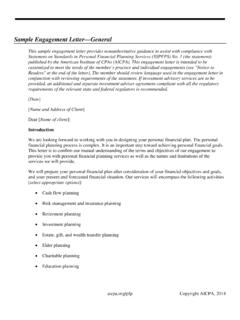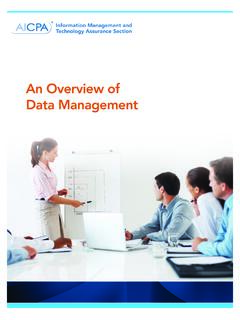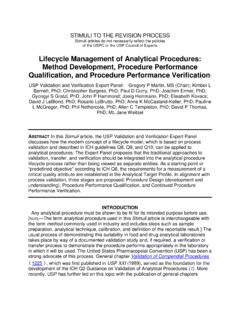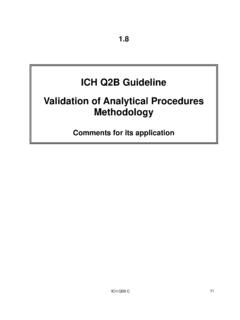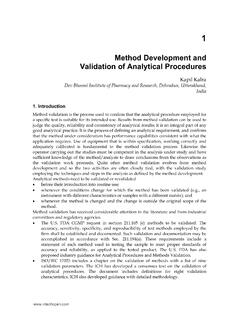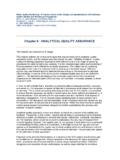Transcription of Analytical Procedures - AICPA
1 Analytical Procedures1889AU Section 329 Analytical Procedures (Supersedes section 318.)Source: SAS No. 56; SAS No. for audits of financial statements for periods beginning on or afterJanuary 1, 1989, unless otherwise section provides guidance on the use of Analytical Procedures andrequires the use of Analytical Procedures in the planning and overall reviewstages of all Procedures are an important part of the audit process andconsist of evaluations of financial information made by a study of plausible re-lationships among both financial and nonfinancial data. Analytical proceduresrange from simple comparisons to the use of complex models involving manyrelationships and elements of data. A basic premise underlying the applicationof Analytical Procedures is that plausible relationships among data may rea-sonably be expected to exist and continue in the absence of known conditions tothe contrary.
2 Particular conditions that can cause variations in these relation-ships include, for example, specific unusual transactions or events, accountingchanges, business changes, random fluctuations, or financial relationships is essential in planning andevaluating the results of Analytical Procedures , and generally requires knowl-edge of the client and the industry or industries in which the client understanding of the purposes of Analytical Procedures and the limitationsof those Procedures is also important. Accordingly, the identification of the rela-tionships and types of data used, as well as conclusions reached when recordedamounts are compared to expectations, requires judgment by the Procedures are used for the following assist the auditor in planning the nature, timing, and extent ofother auditing a substantive test to obtain audit evidence about particular asser-tions related to account balances or classes of an overall review of the financial information in the final reviewstage of the auditAnalytical Procedures should be applied to some extent for the purposes re-ferred to in (a) and (c) above for all audits of financial statements made inaccordance with generally accepted auditing standards.
3 In addition, in somecases, Analytical Procedures can be more effective or efficient than tests of de-tails for achieving particular substantive testing objectives. [Revised, March,2006, to reflect conforming changes necessary due to the issuance of Statementon Auditing Standards No. 105.].05 Analytical Procedures involve comparisons of recorded amounts, orratios developed from recorded amounts, to expectations developed by the au-ditor. The auditor develops such expectations by identifying and using plausibleAU Standards of Field Workrelationships that are reasonably expected to exist based on the auditor's under-standing of the client and of the industry in which the client operates. Followingare examples of sources of information for developing information for comparable prior period(s) giving consider-ation to known results for example, budgets, or forecasts including ex-trapolations from interim or annual among elements of financial information within the regarding the industry in which the client operates forexample, gross margin of financial information with relevant nonfinancial in-formationAnalytical Procedures in Planning the purpose of applying Analytical Procedures in planning the audit isto assist in planning the nature, timing, and extent of auditing Procedures thatwill be used to obtain audit evidence for specific account balances or classes oftransactions.
4 To accomplish this, the Analytical Procedures used in planning theaudit should focus on (a) enhancing the auditor's understanding of the client'sbusiness and the transactions and events that have occurred since the last auditdate, and (b) identifying areas that may represent specific risks relevant to theaudit. Thus, the objective of the Procedures is to identify such things as theexistence of unusual transactions and events, and amounts, ratios and trendsthat might indicate matters that have financial statement and audit planningramifications. [Revised, March, 2006, to reflect conforming changes necessarydue to the issuance of Statement on Auditing Standards No. 105.].07 Analytical Procedures used in planning the audit generally use dataaggregated at a high level. Furthermore, the sophistication, extent and timingof the Procedures , which are based on the auditor's judgment, may vary widelydepending on the size and complexity of the client.
5 For some entities, the pro-cedures may consist of reviewing changes in account balances from the priorto the current year using the general ledger or the auditor's preliminary or un-adjusted working trial balance. In contrast, for other entities, the proceduresmight involve an extensive analysis of quarterly financial statements. In bothcases, the Analytical Procedures , combined with the auditor's knowledge of thebusiness, serve as a basis for additional inquiries and effective Analytical Procedures used in planning the audit often useonly financial data, sometimes relevant nonfinancial information is consideredas well. For example, number of employees, square footage of selling space,volume of goods produced, and similar information may contribute to accom-plishing the purpose of the Procedures Used as Substantive auditor's reliance on substantive tests to achieve an audit objectiverelated to a particular assertion1may be derived from tests of details, from1 Assertions are representations by management that are embodied in financial statement compo-nents.
6 See section 326,Audit Evidence. [Revised, March 2006, to reflect conforming changes necessarydue to the issuance of Statement on Auditing Standards No. 106.]AU Procedures1891analytical Procedures , or from a combination of both. The decision about whichprocedure or Procedures to use to achieve a particular audit objective is basedon the auditor's judgment on the expected effectiveness and efficiency of theavailable auditor considers the level of assurance, if any, he wants fromsubstantive testing for a particular audit objective and decides, among otherthings, which procedure, or combination of Procedures , can provide that level ofassurance. For some assertions, Analytical Procedures are effective in providingthe appropriate level of assurance. For other assertions, however, analyticalprocedures may not be as effective or efficient as tests of details in providingthe desired level of expected effectiveness and efficiency of an Analytical procedurein identifying potential misstatements depends on, among other things, (a) thenature of the assertion, (b) the plausibility and predictability of the relationship,(c) the availability and reliability of the data used to develop the expectation,and (d)
7 The precision of the of Procedures may be effective and efficient tests for assertionsin which potential misstatements would not be apparent from an examinationof the detailed evidence or in which detailed evidence is not readily example, comparisons of aggregate salaries paid with the number of per-sonnel may indicate unauthorized payments that may not be apparent fromtesting individual transactions. Differences from expected relationships mayalso indicate potential omissions when independent evidence that an individ-ual transaction should have been recorded may not be readily and Predictability of the is important for the auditor to understand the reasons that makerelationships plausible because data sometimes appear to be related when theyare not, which could lead the auditor to erroneous conclusions.
8 In addition, thepresence of an unexpected relationship can provide important evidence whenappropriately higher levels of assurance are desired from Analytical Procedures ,more predictable relationships are required to develop the expectation. Rela-tionships in a stable environment are usually more predictable than relation-ships in a dynamic or unstable environment. Relationships involving incomestatement accounts tend to be more predictable than relationships involv-ing only balance sheet accounts since income statement accounts representtransactions over a period of time, whereas balance sheet accounts representamounts as of a point in time. Relationships involving transactions subject tomanagement discretion are sometimes less predictable. For example, manage-ment may elect to incur maintenance expense rather than replace plant andequipment, or they may delay advertising and Reliability of may or may not be readily available to develop expectations forsome assertions.
9 For example, to test the completeness assertion, expected salesfor some entities might be developed from production statistics or square feet ofselling space. For other entities, data relevant to the assertion of completenessof sales may not be readily available, and it may be more effective or efficientto use the details of shipping records to test that Standards of Field auditor obtains assurance from Analytical Procedures based uponthe consistency of the recorded amounts with expectations developed from dataderived from other sources. The reliability of the data used to develop the ex-pectations should be appropriate for the desired level of assurance from theanalytical procedure. The auditor should assess the reliability of the data byconsidering the source of the data and the conditions under which it was gath-ered, as well as other knowledge the auditor may have about the data.
10 Thefollowing factors influence the auditor's consideration of the reliability of datafor purposes of achieving audit objectives: Whether the data was obtained from independent sources outside theentity or from sources within the entity Whether sources within the entity were independent of those who areresponsible for the amount being audited Whether the data was developed under a reliable system with ade-quate controls Whether the data was subjected to audit testing in the current or prioryear Whether the expectations were developed using data from a variety ofsourcesPrecision of the expectation should be precise enough to provide the desired levelof assurance that differences that may be potential material misstatements,individually or when aggregated with other misstatements, would be identifiedfor the auditor to investigate (see paragraph.)
